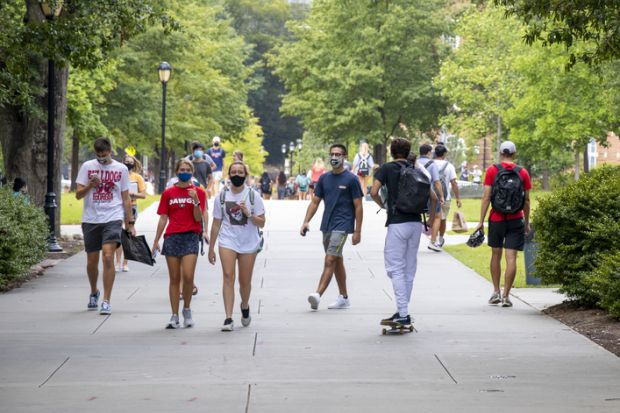A tiny minority of people infected with Covid-19 account for the vast majority of its spread on college campuses, suggesting the need for greater emphasis on control strategies based on detailed test results, University of Colorado experts have found.
The research, now in the early stages of scientific peer review, found that just 2 per cent of infected people are carrying 90 per cent of the existing amounts of virus.
Another non-reviewed study from the university, with even more direct implications for campus life, found that only a fifth of infected students living in dormitories had infected their room-mate.
“Extreme viral loads are concentrated in a small number of people,” said Kristen Bjorkman, a postdoctoral research associate at the University of Colorado Boulder, who was part of the research team.
The implications, Dr Bjorkman said, included the need for test results that reflect viral load rather than a simple positive or negative outcome, with containment strategies concentrated on those people with highest viral loads.
For its study of room-mate transmission, the Colorado researchers examined data on more than 6,000 students in their residence halls during the autumn 2020 semester.
They found that infected students who likely transmitted the virus to their room-mates had an average viral load about 6.5 times higher than those who did not spread the disease. From considering isolation practices and other factors, they concluded that high viral load was the clearest connection to transmission of the infection.
For their other study, the researchers analysed data from more than 72,000 saliva-based Covid tests on campus. They found half of those testing positive had virus levels that rendered them essentially non-infectious, while 2 per cent carried 90 per cent of all the virus found.
“It remains unknown whether these are special individuals capable of harbouring extraordinarily high viral loads, or whether many infected individuals pass through a very short time period of extremely high viral load,” the research team writes.
Yet, they write, “a strong implication is that these individuals who are viral super-carriers may also be super-spreaders”.
The finding on viral load, combined with the finding on room-mates, suggests that policymakers should be far more aggressive in obtaining test results that measure and report virus quantities in people who are tested, Dr Bjorkman said.
One outside expert, Monica Gandhi, a professor of medicine at the University of California at San Francisco best known for her work on HIV, said the study appeared to be a valuable contribution to figuring out how Covid spreads and how to fight back.
“It would explain some of the mystery” about the variations in spread, Professor Gandhi said.
The Colorado work appeared especially valuable because it included a variety of test subjects across campus, not just students, she said. But its limitations, she said, included the possibility that viral loads vary greatly over time in many patients and that the 2 per cent figure may actually reflect those with high loads just at the moment of the test.
Test providers aren’t barred by law from revealing data on viral load, Professor Gandhi said, though there’s been significant and inexplicable political pressure in the US not to do so. “With all my heart, I can’t understand it,” she said.
Register to continue
Why register?
- Registration is free and only takes a moment
- Once registered, you can read 3 articles a month
- Sign up for our newsletter
Subscribe
Or subscribe for unlimited access to:
- Unlimited access to news, views, insights & reviews
- Digital editions
- Digital access to THE’s university and college rankings analysis
Already registered or a current subscriber? Login








